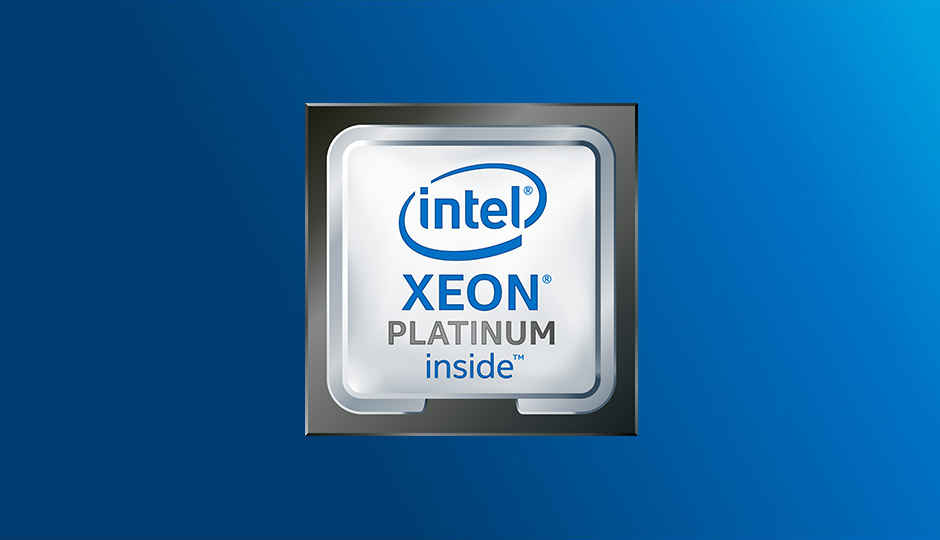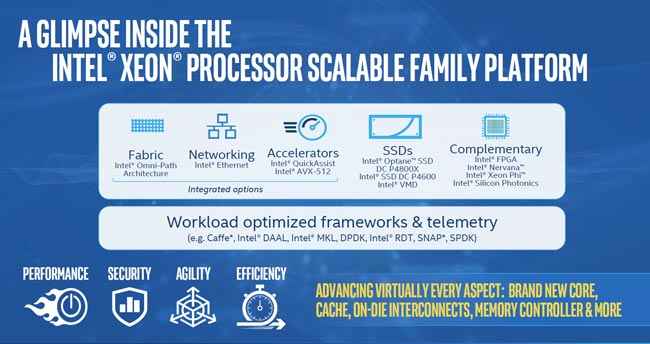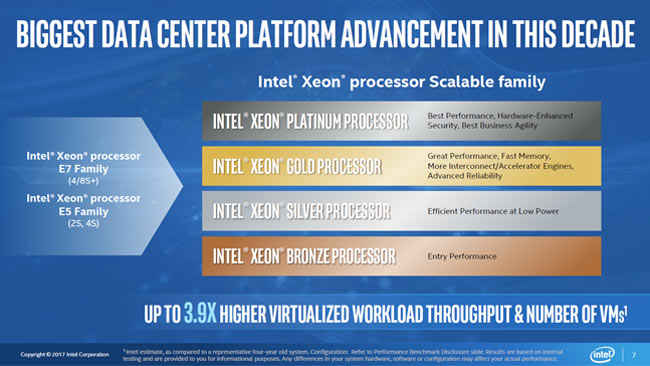Intel rebrands Xeon processors to align with newer scalability features

Intel Xeon E3 / E5 / E7 to be known as Intel Xeon Platinum / Gold / Silver / Bronze
Processor nomenclature has long been somewhat alien to the average Joe. While efforts over the past decade have somewhat made processor names less overwhelming, the mere fact that there are hundreds of SKUs to choose from with all of them having intimidating names has made it difficult for someone new to the server business. To address this complexity as well as to align with the new direction that Intel is taking with their Xeon line-up, Intel will be doing away with the older ExVx nomenclature and making way for a new system. Instead of the E3, E5 and E7 system, the Intel Xeon platform will now be segregated across the performance spectrum and will be labelled as Platinum, Gold, Silver and Bronze. Platinum being the flagship tier, followed by Gold, Silver and Bronze. Another welcome feature is that the new lineup can be swapped out with any of the other SKUs without the need to switch sockets/chipsets.
What brought on this change?
Intel states that clear segregation between businesses have started to narrow down and there’s greater agility between different usage scenarios. There certainly has been a huge rise in Big Data applications with more and more applications and services moving to the cloud. The cloud in this context is hosted on server blades. And there has been an increase in the number of hybrid application scenarios (or applications which are a blend of applications which were previously individual). The increased agility in the server space implies that the existing usage specific hardware should make way for hardware that scales according to demand. In a way, the server business is moving away from a ‘Master of one’ approach to a ‘Jack of all trades’ approach. Scalable solutions aren’t new. However, the software portion contributed more to the scalability factor than the hardware, hence, the need for hardware which can be scaled as well. Thus, leading to a more optimised solution at the end of the day.

What’s new with the upcoming Xeon
The upcoming Intel Xeon lineup is supposedly designed to be scalable. So you can now retain the same hardware and just swap out the processor based on your workload. Should you need more power, you can switch to a Xeon Platinum processor and if you wish to scale down (owing to unused resources or any appropriate reason) then you can move to a Xeon Silver or Xeon Bronze SKU.
However, even without swapping out the processors, the newer lineup will supposedly be optimised to handle a variety of workloads. And its compute, storage and network capabilities have been reworked as compared to the previous generation resulting in a performance boost as well. Thanks to Intel Omnipath Architecture for the interconnects, the individual hardware components on the new Xeon platform will be able to talk to each other with lower latencies and thus handle greater workload within the same time period. Additionally, improved feature sets like AVX-512 makes it easier to perform the same compute operations in a more optimised fashion. Intel says they’re coming up with a new core design, memory controller and networking chipset. Additionally, the new Optane based SSD, DC P4800X, will help it store large data sets which are fetchable much faster thanks to the improved transfer speeds of 3D XPoint memory technology. Compared to a four-year-old Xeon system, the newer lineup is supposedly capable of handling up to 3.9x higher virtualised workload throughput and virtual machines.
New Intel Xeon Nomenclature
Here’s how Intel is segregating the new Xeon lineup. As mentioned previously, the Platinum is the flagship series followed by the Gold, Silver and Bronze series.
- Intel® Xeon® PLATINUM PROCESSOR Best Performance, Hardware-Enhanced Security, Best Business Agility
- Intel® Xeon® GOLD PROCESSOR Great Performance, Fast Memory, More Interconnect/Accelerator Engines, Advanced Reliability
- Intel® Xeon® SILVER PROCESSOR Efficient Performance at Low Power
- Intel® Xeon® BRONZE PROCESSOR Entry Performance
What other reasons are there?
Given that those who deal with enterprise products like the Xeon Processors are way better informed, this has never been a problem. However, with more startups emerging and even greater competition in the enterprise market, it has become imperative that companies step up their efforts to make it easier for the consumer. Intel’s Xeon platform has been dominating the enterprise segment for quite a while, especially since AMD’s offering in the form of Opteron received the biggest update (Jaguar) back in 2013. However, with the recent announcement of its successor, the Zen architecture based Naples, Intel has found one extra reason to bring about this new change.
Mithun Mohandas
Mithun Mohandas is an Indian technology journalist with 10 years of experience covering consumer technology. He is currently employed at Digit in the capacity of a Managing Editor. Mithun has a background in Computer Engineering and was an active member of the IEEE during his college days. He has a penchant for digging deep into unravelling what makes a device tick. If there's a transistor in it, Mithun's probably going to rip it apart till he finds it. At Digit, he covers processors, graphics cards, storage media, displays and networking devices aside from anything developer related. As an avid PC gamer, he prefers RTS and FPS titles, and can be quite competitive in a race to the finish line. He only gets consoles for the exclusives. He can be seen playing Valorant, World of Tanks, HITMAN and the occasional Age of Empires or being the voice behind hundreds of Digit videos. View Full Profile





